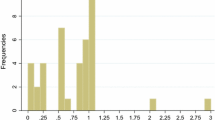Abstract
Various dairy companies' allocation of school milk contracts using signalling, sham bids to honor incumbency and other devices are examined to determine whether bidding was collusive or pure oligopolistic interdependent behavior following noncooperative game theory. The schemes used to allocate contracts were found to be efficient methods for reaching agreements. Since pure interdependent (noncoorperative) behavior requires rivals to corelate signals, coordinate expectations, and resolve timing-uncertainty problems within sealed-bidding constraints, detailed analysis of the economic evidence of bidding practices requires rejection of a Nash equilibrium explanation for the behavior.
Similar content being viewed by others
References
Areeda, Phillip E. and Hovenkamp, Herbert (Supp. 1991) Antitrust Law, ¶1405, pp. 952–953.
ArquitKevin J. (Winter 1993) ‘The Boundaries of Horizontal Restraints: Facilitating Practices and Invitations to Collude’, Antitrust Law Journal, 61, 531–548.
Asch, Peter (Spring 1969) ‘Collusive Oligopoly’, Antitrust Law and Economics Review, pp. 53–68.
AschPeter and SenecaJ. J. (February 1976) ‘Is Collusion Profitable?’, The Review of Economics and Statistics, LVIII, 1–12.
BlackHenry Campbell (1979) Black's Law Dictionary, St. Paul, Minn.: West Publishing Company, pp. 280.
BakerJonathan B. (Spring 1993) ‘Two Sherman Act Section 1 Dilemmas: Parallel Pricing, the Oligopoly Problem, and Contemporary Economic Theory’, Antitrust Bulletin, 38, 143–219.
BlockMichael K. and FeinsteinJonathan S. (February 1986) ‘The Spillover Effect of Antitrust Enforcement’, Review of Economics and Statistics, LXVIII, 122–131.
BorkRobert H. (1978) Antitrust Paradox: A Policy at War With Itself, New York: Basic Books Incorporated.
Commerce Clearing House (July 12, 1995) Trade Regulation Reports, ¶70, pp. 625.
Clark, Donald S. (1983) ‘Price Fixing Without Collusion: An Analysis of Facilitating Practices After Ethyl Corp.’, Wisconsin Law Review, pp. 887–952.
ElzingaKenneth G. and BreitWilliam (1976) The Antitrust Penalties: A Study in Law and Economics, New Haven, Conn.: Yale University Press.
Erickson, W. B. (Spring 1969) ‘Economics of Price Fixing’, Antitrust Law and Economics Review, pp. 83–122.
FraasArthur G. and GreerDouglas F. (September 1977) ‘Market Structure and Price Collusion: An Empirical Analysis’, Journal of Industrial Economics, XXVI, 21–44.
FriedmanJames W. (1983) Oligopoly Theory, Cambridge: Cambridge University Press.
FudenbergDrew and TiroleJean (1989) ‘Noncooperative Game Theory for Industrial Organization: An Introduction and Overview’, in RichardSchmalensee and Robert D.Willig (eds.), Handbook of Industrial Organization, Amsterdam; New York: North-Holland, pp. 259–327.
Government Accounting Office (December 1993) ‘Food Assistance: Information on Costs in the National School Lunch Program’, Briefing Report to Congressional Requesters.
GreenEdward J. and PorterRobert H. (January 1984) ‘Noncooperative Collusion under Imperfect Price Information’, Econometrica, 52(1), 87–100.
GriffinJames M. and TeeceDavid J. (1982) OPEC Behavior and World Oil Prices. London; Boston: Allen & Unwin.
HarsanyiJohn C. (1967–1968) ‘Games with Incomplete Information Played by ‘Bayesian’ Players’, Management Science, 14, 159–182, 320–334, and 486–502.
HayGeorge A. and KelleyDaniel (April 1974) ‘An Empirical Survey of Price Fixing Conspiracies’, Journal of Law and Economics, XVII, 13–38.
Hay, George A. (1989) ‘Practices that Facilitate Cooperation: The Ethyl Case’, The Antitrust Revolution, pp. 183–207.
JacqueminAlexis and SladeMargaret E. (1989) ‘Cartels, Collusion, and Horizontal Merger’, in RichardSchmalensee and Robert D.Willig (eds.), Handbook of Industrial Organization, Amsterdam; New York: North-Holland, pp. 415–473.
Kuhlman, J. M. (Spring 1969) ‘Nature and Significance of Price Fixing Rings’, Antitrust Law and Economics Review, pp. 69–82.
MacAvoyPaul W. (1977) Federal Milk Marketing Orders and Price Supports, Washington: American Enterprise Institute for Public Policy Research.
NashJr. and JohnF. (September 1951) ‘Noncooperative Games’, Annals of Mathmatics, 54, 286–295.
PosnerRichard A. (June 1969) ‘Oligopoly and the Antitrust Laws: A Suggested Approach’, Stanford Law Review, 21, 1562–1696.
PosnerRichard A. (1976) Antitrust Law, an Economic Perspective, Chicago: University of Chicago Press.
Salop, Steven C. (1986) ‘Practices that (Credibly) Facilitate Oligopoly Co-ordination, New Developments in the Analysis of Market Structure’, in Stiglitz, Joseph E. and Mathewson, G. Frank (eds.), International Economics Association, pp. 265–290.
ShapiroCarl (1989) ‘Theories of Oligopoly Behavior’, in RichardSchmalensee and Robert D.Willig (eds.), Handbook of Industrial Organization, Amsterdam; New York: North-Holland, pp. 329–414.
ShenefieldJohn H. and StelzerIrwin M. (1993) The Antitrust Laws: A Primer. Washington, D.C.: The AEI Press.
ShubikMartin (1984) Game Theory in the Social Sciences. Cambridge: MIT Press.
ShughartWilliam F. (1990) The Organization of Industry. Homeword, IL: BPI/Irwin.
Smith, Richard A. (April 1961) ‘The Incredible Electrical Conspiracy’, Fortune, pp. 132–137.
Sonnenfeld, Jeffrey, and Lawrence, Paul R. (July–August 1978) ‘Why Do Companies Succumb to Price Fixing?’, Harvard Business Review, pp. 145–157.
Stigler, George J. (October 1966) ‘Economic Effects of the Antitrust Laws’, Journal of Law and Economics, IX, reprinted in The Organization of Industry, pp. 268. Homewood, Ill.: Richard D. Irwin.
StockingGeorge W. and WatkinsMyron W. (1948) Cartels or Competition. New York: Twentieth Century Fund.
SultanRalph G. M. (1974) Pricing in the Electrical Oligopoly, Cambridge, Mass.: Harvard University Press.
Turner, D. F. (February 1962) ‘The Definition of Agreement under the Sherman Act: Conscious Parallelism and Refusals to Deal’, Harvard Law Review, pp. 655–706.
U.S. Department of Agriculture, Economic Research Service, ‘Economic Effects of Federal Contributions to the U.S. School Lunch Program: Calendar Year 1972 and FY 1974’, Agricultural Economic Report No. 350.
U.S. Department of Agriculture, Food and Nutrition Services (December 1982) ‘Special Milk Program Evaluation and National School Lunch Program Survey’, FNS-167, 1978.
VonNeumannJohn and MorgensternOskar (1944) Theory of Games and Economic Behavior, Princeton: Princeton University Press.
Waldman, Don E. (Spring 1988) ‘The Inefficiencies of ‘Unsuccessful’ Price Fixing Agreements’, Antitrust Bulletin, pp. 67–93.
World Almanac and Book of Facts, The, 1994, p. 123.
Author information
Authors and Affiliations
Rights and permissions
About this article
Cite this article
Lanzillotti, R.F. The great school milk conspiracies of the 1980s. Rev Ind Organ 11, 413–458 (1996). https://doi.org/10.1007/BF00157772
Issue Date:
DOI: https://doi.org/10.1007/BF00157772




